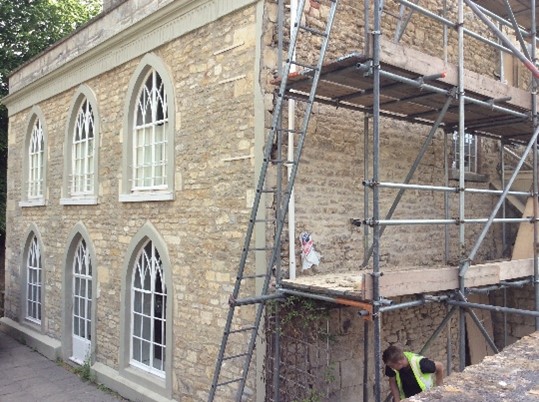Externally applied solid wall insulation
These walls would have originally been rendered and it is perfectly acceptable to reinstate render with some insulation. This represents an opportunity for energy efficiency and heritage gain.
This measure can help where external walls are poorly insulated and there is no cavity. It can also be employed where walls are insufficiently weathertight causing excessive drafts and heat loss, this can be particularly appropriate for end terrace properties.
The effectiveness of the insulation will vary with the type of insulation chosen, thickness and configuration of the existing building. For most buildings, an improvement in the thermal performance of walls will be improved by around 35%.
Energy Saving Trust report that the average household could save £475 a year on energy bills by installing external solid wall insulation. They estimate the total cost of installing a standard system as around £10,000. According to data from BEIS, the estimated cost of external wall insultation is between £55 and £180 per m2.This may be a more expensive solution than internal wall insulation, although it may be less disruptive for occupants. Other housing types, such as terraces, may differ.
Buildings with a solid wall construction rely on the transference of moisture from within the wall so that it can be dissipated as vapour. This process relies on adequate ventilation, otherwise insulation is likely to cause harm to fabric due to the increase in levels of damp and interstitial condensation between the existing wall surfaces. With EWI, there is also a risk of cold bridging for attached neighbouring properties if their walls haven’t also been insulated.
A desire is expressed for natural breathable insulants, such as hemp fibre, wool and cellulose. Breathable paints and decorative treatments (including wallpaper) must also be used to ensure that moisture can dissipate. Cement-based insulating products are discouraged. If applying lime render, you must first remove painting in order for it to adhere.
Listed Building Consent is required for external wall insulation. This measure is more likely to be considered acceptable on less-visible building facades compared to principle elevations.
Vapour permeable insulation materials should always be used to allow moisture transfer through the walls.
Where painting is proposed, permeable paints should be used (e.g. limewash or mineral paint) to retain the permeability of the insulating material and to achieve an appropriate finish and presentation of the building.
Lime render is most appropriate for historic buildings.
Great care is necessary to ensure that detailing at roof eaves, and window and door reveals does not adversely affect the building’s appearance or ability to shed rainwater.
If there is any evidence of damp within the walls, this must be resolved before applying insulation. This may not be possible if there are external details which could be covered up, such as string courses.
We support the use of externally applied solid wall insulation where appropriate.
In the light of the Climate Emergency, we will generally permit and encourage alterations on listed buildings, with special regard to the the following:
- Preserving the building, its setting or any features of special architectural or historic interest which it possesses
- Preserving or enhancing the character of a conservation area
- Respecting the significance of any non-designated heritage asset
Energy Efficiency and Historic Buildings: Insulating Solid Walls from Historic England.


